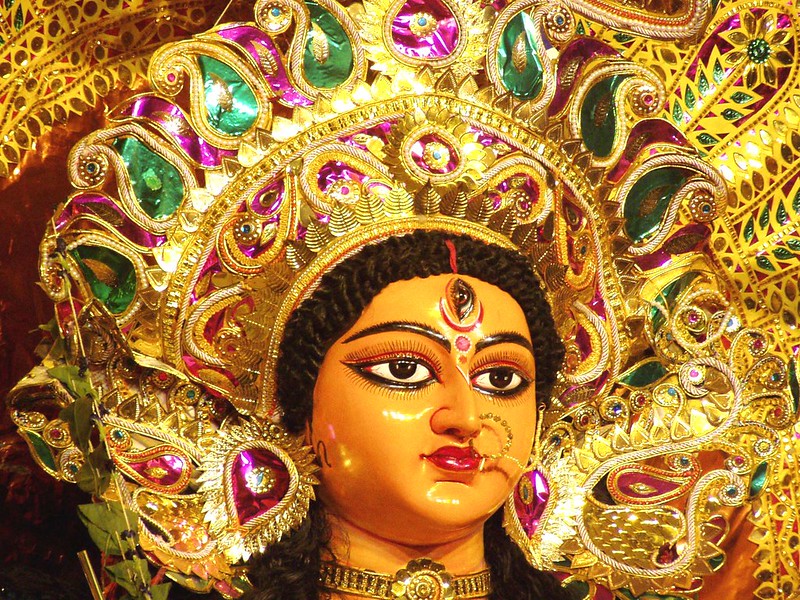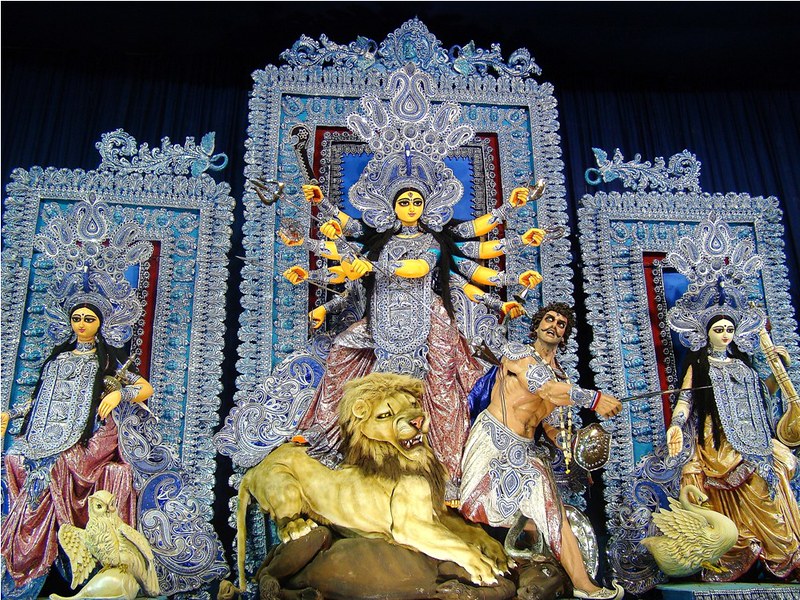Durga Puja in Kolkata
A Miraculous Festival Where Art, Faith, and Community Transform the City
2026/10/17 - 2026/10/22
Durga Puja is Kolkata’s largest Hindu festival, celebrating the victory of Goddess Durga over evil.
Every autumn, the city of Kolkata transforms into a vast art gallery for Durga Puja. As the biggest festival in West Bengal and a UNESCO Intangible Cultural Heritage, it draws millions of locals and travelers over five to ten days. People wander from one dazzling pandal (temporary temple) to another, experiencing the creativity, color, and devotion that fill every corner of the city. Whether you’re a first-time visitor or a lifelong devotee, Durga Puja in Kolkata is a citywide celebration of the goddess’s victory, Bengali culture, and the bonds between people.
The air is thick with the scent of incense, fried snacks, and flowers; the sound of drums, conch shells, and laughter; the feel of silk sarees and cool clay idols…this is a festival for all five senses. Durga Puja in Kolkata is not just a religious event, but also an art festival, a family reunion, and a citywide experience of unity.
Main Attractions
Pandal Hopping: Kolkata’s Pop-Up Temples
The heart of the festival is the pandals (temporary temples) built throughout the city. Each neighborhood competes with unique themes, from recreations of world landmarks to social issues, showcasing artistry and creativity. Must-see pandals include Sovabazar Raja Barir Puja, Bagbazar (famous for artistic brilliance), Rani Rashmoni, and Bholanath Mallick Barir Puja. At night, the city is illuminated, and crowds flow from pandal to pandal, taking photos and soaking in the festive energy.
Kumartuli: The Idol-Makers’ District
Before the festival, visit Kumartuli, where generations of artisans create clay idols of Durga. Watching these craftsmen shape, paint, and dress the goddess is a moving experience that reveals the creative soul of the festival.
Cultural Performances & Community Events
Each pandal is a cultural hub, hosting music, dance, poetry readings, and art exhibitions. Local artists and musicians perform, and there are cooking and craft contests, keeping the festive spirit alive and participatory.
Main Rituals: Saptami, Ashtami, Navami, Dashami
The main rituals take place on Saptami (7th day), Ashtami (8th), and Navami (9th), featuring elaborate prayers, offerings, and the mesmerizing Dhunuchi Naach (dance with incense burners). On Dashami (10th day), married women participate in Sindoor Khela (smearing each other with vermillion), and the emotional Visarjan procession carries the idols to the river for immersion.
Costumes and Decorations
Durga Puja is also a festival of fashion. Women wear traditional red-and-white sarees or vibrant silks and handloom sarees, while men don new kurtas. Homes and pandals are decorated with marigold garlands, lights, and rangoli, and the goddess idols are adorned with gold, bright fabrics, and flowers.
Traditional Food & Drink
Food is central to the festival. Communal bhog (sacred vegetarian feast) is served at pandals: khichuri (spiced rice and lentils), luchi (fried bread), labra (vegetable curry), and sweets like sandesh and rasgulla. Street stalls offer Kolkata favorites like phuchka (pani puri), kathi rolls, fish chops, kobiraji cutlets, and deviled eggs. The aroma of ghee, spices, and sweets fills the air, making food a highlight of the celebration.
Cultural and Historical Background
The origins of Kolkata’s Durga Puja date back to the late 16th century, when wealthy zamindars (landlords) hosted grand pujas in their mansions to display their power, wealth, and devotion. At that time, the puja was a private event for family and invited guests, featuring lavish offerings, music, dance, and poetry readings-a blend of social gathering and worship.
From the late 19th to early 20th century, waves of social change brought the rise of Baroari (public) pujas. These were funded by groups of families or neighborhoods, making the festival open to all as a true “people’s celebration.” Especially after the 1905 Partition of Bengal, Durga Puja became a symbol of Bengali unity, pride, and nationalism, serving as a platform for resistance to British colonial rule and social movements. The themes and decorations of pandals often reflect social issues, current events, or political messages.
Today, Durga Puja is the very soul of Kolkata, deeply embedded in the city’s identity. Families and relatives return home during the festival, and artists and craftsmen compete to create the most stunning pandals and goddess idols. The five days of celebration honor not only the myth of Durga’s victory over the demon Mahishasura, but also the power of art, creativity, and community. In 2021, its cultural value was recognized by UNESCO as an Intangible Cultural Heritage.
Durga Puja is far more than a religious event-it is a season of homecoming and reunion, a living tradition that strengthens family and community bonds, celebrates Bengali pride, artistic creativity, diversity, and continues to send messages to modern society.
Participant Voices
As a photographer, Durga Puja in Kolkata is a dream. The colors, the lights, the expressions-every moment is a picture. In Bagbazar and Sovabazar, I spoke with artisans and captured the faith in their eyes. It was more than a festival; it was a life-changing experience.
Fun Facts
- Some pandals cost over $100,000 to create, with themes ranging from world heritage sites to social issues.
- During Sindoor Khela, married women joyfully smear each other with vermillion, wishing for marital happiness and longevity.
Festival Dates
Durga Puja is held every autumn in Kolkata, West Bengal. Especially during the five main days from Saptami to Dashami, the entire city overflows with art, music, rituals, and the energy of millions-a must-experience festival at least once in a lifetime.
The event schedule is subject to change. Please check the official website for the most up-to-date information.
Information
| Name | Durga Puja in Kolkata |
| Country | India |
| Area | Kolkata |
| Date | 2026/10/17 - 2026/10/22 |
| Link |
Upcoming Festivals
Whirling Dervishes Festival Turkey
A Mesmerizing Dance of Divine Love
2025/12/06Mevlana Celaleddin Rumi Commemoration Ceremony ( Şeb-i Arus ) Turkey
A Whirling Journey to Divine Love
2025/12/10Dia de la Virgen de Guadalupe Mexico
A Festival Weaving Faith, Fervor, and Mexican Identity
2025/12/11L'Escalade Switzerland
Geneva’s Grand Winter Festival of Courage, Chocolate, and Community
2025/12/12Umkhosi Wokweshwama South Africa
The Zulu First Fruits Festival—A Sacred Celebration of Land, Ancestors, and Renewal
2025/12/12Lucia Festival (St. Lucia's Day) Sweden
A Festival of Light Illuminating the Nordic Darkness
2025/12/15Las Posadas Mexico
The Luminous Quest for Sacred Shelter
2025/12/22Noche de Rabanos (Night of the Radishes) Mexico
A celebration blending art, farming heritage, and cultural traditions
2025/12/23Chant of the Sybil on Majorca Spain
A Medieval Prophecy Echoes Through Majorcan Christmas
2025/12/23‘Hatajo de Negritos’ and the ‘Hatajo de Pallitas’ Peru
A Christmas Festival of Rhythm, Faith, and Afro-Andean Heritage in Peru’s Ica Region


